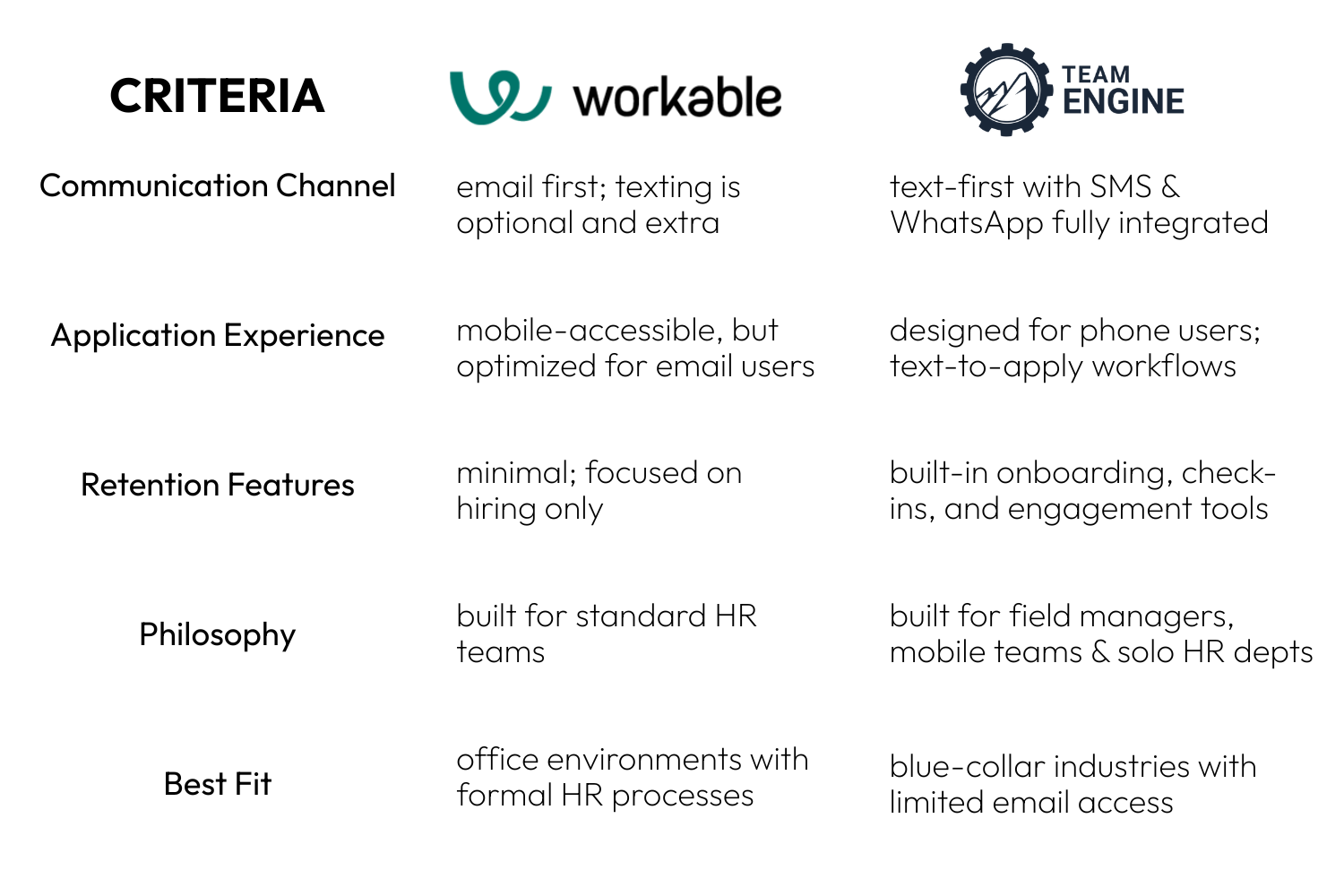
It’s Time to Prioritize Mobile Recruiting Software
Why mobile recruiting software is now essential for hiring deskless workers, and how text-first tools are solving ghosting, drop-off, and early turnover.

For decades, the software industry has failed 80% of the global workforce.
These are the people who power construction sites, warehouses, hospitals, farms, and job sites. The people who make and move things. The ones who don’t sit at desks. And yet, in a world flooded with HR tech, very little of it was built with them in mind.
That’s beginning to change and a clear shift is underway. Companies in field-based industries are waking up to a truth that many have long ignored: you can’t hire a mobile workforce with desktop software, or without mobile recruiting software built for the way these teams operate.
The Unseen Majority
The term "deskless worker" may sound like a niche category. It’s not. It describes nearly 3 billion people worldwide—more than 80% of the total global workforce. These workers are found in industries like construction, manufacturing, logistics, retail, hospitality, and healthcare. And despite their critical role in the economy, they’ve been largely ignored by traditional recruiting platforms.
While white-collar teams have enjoyed sleek applicant tracking systems and AI-assisted sourcing tools, most deskless workers are stuck navigating clunky job applications and outdated communication practices. Why? Because only 1% of venture capital in enterprise software goes toward tools built for this population.
The result? A deep technology divide that contributes directly to burnout, turnover, and stalled business growth.
The Cost of Disconnection
Consider this: 83% of deskless employees don’t have a company email address. Yet most companies still default to email as their primary internal communication channel. Predictably, it doesn’t work.
Workers feel out of the loop. Managers are frustrated by delayed (or absent altogether) replies. And when new hires ghost or quit early, employers are left wondering what went wrong.
But the signs are all there:
- 84% of deskless workers say they don’t receive enough direct communication from leadership.
- 53% report feeling burned out.
- 43% are actively looking for another job.
What looks like a tough labor market is often the result of misaligned systems. Thankfully, those can be fixed.
Why Mobile Is Now the Front Door to Your Workforce
The good news? The solution is already in everyone’s pocket.
Smartphones have become the primary gateway to work for the deskless workforce. 65% of job seekers are using mobile devices to find work. But only 41% of recruiters are using mobile to source candidates. That’s a missed connection waiting to be fixed.
If you’re wondering, “Is there an app that lets me post jobs and review applicants on the go?”—yes, there are, and mobile recruiting software platforms like Team Engine are leading the charge. These tools are built so managers can review resumes, message applicants, and even schedule interviews without ever stepping foot in the office.
A well-designed mobile recruitment app can bridge this gap, enabling hiring teams to connect with candidates faster and more effectively. SMS, in particular, is emerging as the most effective communication channel:
- Texts have a 98% open rate (compared to ~21% for email).
- Candidates respond to texts within 90 seconds, on average.
- 89% of job seekers say they prefer texting over phone or email.
Text messaging meets deskless workers where they are. It’s fast. It’s familiar. And it doesn’t require them to log into a portal or check an inbox they don’t have.
But speed and accessibility are just the beginning. To truly compete for talent in 2025 and beyond, employers need to rethink the entire hiring process from a mobile-first perspective, ideally using a mobile recruiting tool built specifically for that purpose.
The Three Pillars of Deskless Hiring
1. Intelligent automation & AI that works while you work
Recruiters and managers don’t have time to chase paperwork or follow up manually. With automation, the process keeps moving, even when they’re out on a job site.
Smart platforms now use artificial intelligence to:
- Screen resumes and match candidates to roles in seconds.
- Ask pre-qualification questions via chatbot.
- Trigger automated responses and reminders via SMS.
That means no more ghosting, fewer delays, and a better experience for everyone.
2. Candidate experience as a competitive edge
The best candidates are off the market in 10 days or less. If your application is clunky or your response time is slow, you’ll lose them.
Mobile recruiting software ensures:
- Simple applications that work on a phone.
- Clear, fast communication from day one.
- Transparency about pay and expectations.
It also means building trust early. And for a workforce that’s used to being ignored or undervalued, that makes all the difference.
3. Retention built into the process
Hiring is only half the battle. Most turnover in blue-collar jobs happens in the first 90 days. That’s why leading platforms now support the entire employee lifecycle, not just the front end.
Look for tools that:
- Automate onboarding check-ins at 30, 60, and 90 days.
- Send quick employee surveys via text.
- Celebrate milestones and surface issues before they become problems.
Mobile Recruiting Tools vs. Traditional ATS Platforms
On the surface, many recruiting tools claim to serve all industries. But when it comes to hiring a mobile, deskless workforce, the design philosophy of the platform matters as much as the features it offers.
At Team Engine, we believe that communication should be immediate, frictionless, and native to how people already operate. This is where most systems fall short, because they’re built for office-based roles. Their workflows assume candidates check email regularly, have time to fill out long applications, and access onboarding documents from a desktop. Those assumptions don’t hold up in the field.
Compare two leading options:
Workable is a well-known, feature-rich ATS that excels in structured environments with dedicated HR teams. It includes job posting, candidate evaluation, interview scheduling, and offer management—all within a polished interface. But its workflows are built around email and desktop usage. SMS functionality is available, but only as a paid add-on (“Texting+”), and it’s not tightly integrated into the core experience.
Team Engine, by contrast, was purpose-built for field-based and deskless industries. It doesn’t treat texting as an optional feature; it’s the foundation of the platform. From "text-to-apply" sourcing to automated SMS screening and onboarding check-ins, every part of the workflow is optimized for fast, mobile communication. It also includes built-in tools for retention (like multilingual messaging, automated surveys, and milestone reminders) that go far beyond the scope of a traditional ATS.
So, is Team Engine better than Workable for mobile hiring? If your workforce is deskless, the answer is yes. Workable is powerful for office jobs, but Team Engine was built from the ground up to handle hiring in the field, without relying on email, desktops, or add-ons.
Here’s how they stack up:

The difference isn’t just technical; it’s strategic. If your workforce is mobile, multilingual, and time-strapped, a platform that assumes otherwise will always fall short.
So, what tools are best for hiring in industries where people don’t use email? The best tools are the ones that rely on texting first, with email and other channels as a backup or failsafe. Solutions like Team Engine use SMS and WhatsApp as the default (not the backup) so they actually reach the people you're trying to hire.
What to Look for in a Hiring Platform
The market is crowded. Here’s a simplified breakdown:
- Generalist ATS (e.g., Workable, Lever): Great for office roles; not tailored to field-based hiring.
- Field Service Apps (e.g., ServiceTitan, Workyard): Built for operations, not recruiting.
- SMS Add-ons (e.g., TextUs, Textedly, EZ Texting): Enhances communication, but doesn't manage the full funnel.
- Deskless-Focused Platforms (e.g., Team Engine): Built to support the full lifecycle, from application to retention, via text.
Is there recruiting software that integrates with text messaging? Yes, absolutely. But it’s important to know whether texting is a tacked-on feature or a core capability.
Platforms like Team Engine are built around SMS from the start, ensuring it's tightly integrated across hiring, onboarding, and engagement. A truly effective mobile recruiting tool must make texting seamless and automated… without extra plugins or workarounds. The right choice depends on your workforce. If your people don’t use email, your hiring software shouldn’t rely on it either.
Using Texting the Right Way
With all the benefits of SMS, it's tempting to treat texting as a silver bullet. But like any powerful tool, it comes with responsibility. A careless or spammy approach can damage your reputation and even violate regulations. Done right, however, texting can humanize and accelerate the hiring process without adding work for already-busy teams.
Here are a few best practices to keep in mind:
Always get consent. Candidates must explicitly opt in to receive text messages. This isn’t just about compliance (though that matters); it’s about respecting boundaries from the start.
Keep it personal. Use the candidate’s name and reference the specific role they applied for. Generic blasts feel impersonal and are more likely to be ignored.
Be clear and concise. Texts should be under 160 characters when possible, with a direct, easy-to-understand call to action (e.g., "Can you interview Tuesday at 3pm? Reply YES or NO").
Respect business hours. No one wants to be woken up by a job offer at 11 p.m. Stick to normal working hours to avoid coming off as intrusive.
Integrate texting into your larger workflow. SMS is most effective when it complements (not replaces) other tools. Think of it as your first line of communication, not your only one.
Choose Software That Matches Your Workforce
Hiring platforms aren’t interchangeable. If your employees work on job sites, in warehouses, or behind the wheel, your software should reflect that reality.
- It should prioritize texting, not email.
- It should work flawlessly from a smartphone.
- It should extend beyond hiring into onboarding, feedback, and retention.
The wrong system, even if it’s feature-rich, can actively work against your goals. It perpetuates disconnection, slows down hiring, and makes your business look out of touch. The right system becomes a strategic asset, especially as mobile usage, candidate preferences, and retention challenges continue to reshape how hiring gets done.
Built for the Realities of Deskless and Mobile Hiring
Team Engine wasn’t adapted for mobile; it was built for it. The platform reflects everything this new hiring environment demands:
- Automation that keeps things moving, even when you’re in the field.
- Text-based workflows that reach applicants and employees instantly.
- Integrated onboarding and retention tools that stop the revolving door.
Team Engine delivers on all three pillars (automation, candidate experience, and lifecycle engagement) because it was purpose-built for deskless work. It's not trying to serve every industry. It's focused on solving the unique challenges of yours.
In 2026 and beyond, hiring success will belong to the companies that act fast, connect meaningfully, and retain talent longer. Mobile recruiting software like Team Engine isn’t just keeping up with change—it’s helping you stay ahead of it.



.png)
